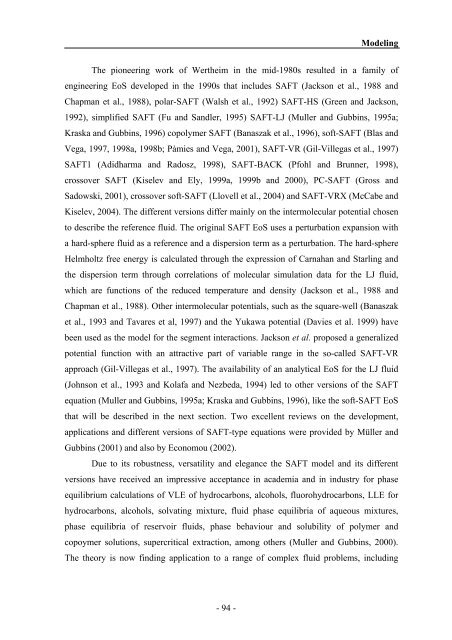n - PATh :.: Process and Product Applied Thermodynamics research ...
n - PATh :.: Process and Product Applied Thermodynamics research ...
n - PATh :.: Process and Product Applied Thermodynamics research ...
Create successful ePaper yourself
Turn your PDF publications into a flip-book with our unique Google optimized e-Paper software.
Modeling<br />
The pioneering work of Wertheim in the mid-1980s resulted in a family of<br />
engineering EoS developed in the 1990s that includes SAFT (Jackson et al., 1988 <strong>and</strong><br />
Chapman et al., 1988), polar-SAFT (Walsh et al., 1992) SAFT-HS (Green <strong>and</strong> Jackson,<br />
1992), simplified SAFT (Fu <strong>and</strong> S<strong>and</strong>ler, 1995) SAFT-LJ (Muller <strong>and</strong> Gubbins, 1995a;<br />
Kraska <strong>and</strong> Gubbins, 1996) copolymer SAFT (Banaszak et al., 1996), soft-SAFT (Blas <strong>and</strong><br />
Vega, 1997, 1998a, 1998b; Pàmies <strong>and</strong> Vega, 2001), SAFT-VR (Gil-Villegas et al., 1997)<br />
SAFT1 (Adidharma <strong>and</strong> Radosz, 1998), SAFT-BACK (Pfohl <strong>and</strong> Brunner, 1998),<br />
crossover SAFT (Kiselev <strong>and</strong> Ely, 1999a, 1999b <strong>and</strong> 2000), PC-SAFT (Gross <strong>and</strong><br />
Sadowski, 2001), crossover soft-SAFT (Llovell et al., 2004) <strong>and</strong> SAFT-VRX (McCabe <strong>and</strong><br />
Kiselev, 2004). The different versions differ mainly on the intermolecular potential chosen<br />
to describe the reference fluid. The original SAFT EoS uses a perturbation expansion with<br />
a hard-sphere fluid as a reference <strong>and</strong> a dispersion term as a perturbation. The hard-sphere<br />
Helmholtz free energy is calculated through the expression of Carnahan <strong>and</strong> Starling <strong>and</strong><br />
the dispersion term through correlations of molecular simulation data for the LJ fluid,<br />
which are functions of the reduced temperature <strong>and</strong> density (Jackson et al., 1988 <strong>and</strong><br />
Chapman et al., 1988). Other intermolecular potentials, such as the square-well (Banaszak<br />
et al., 1993 <strong>and</strong> Tavares et al, 1997) <strong>and</strong> the Yukawa potential (Davies et al. 1999) have<br />
been used as the model for the segment interactions. Jackson et al. proposed a generalized<br />
potential function with an attractive part of variable range in the so-called SAFT-VR<br />
approach (Gil-Villegas et al., 1997). The availability of an analytical EoS for the LJ fluid<br />
(Johnson et al., 1993 <strong>and</strong> Kolafa <strong>and</strong> Nezbeda, 1994) led to other versions of the SAFT<br />
equation (Muller <strong>and</strong> Gubbins, 1995a; Kraska <strong>and</strong> Gubbins, 1996), like the soft-SAFT EoS<br />
that will be described in the next section. Two excellent reviews on the development,<br />
applications <strong>and</strong> different versions of SAFT-type equations were provided by Müller <strong>and</strong><br />
Gubbins (2001) <strong>and</strong> also by Economou (2002).<br />
Due to its robustness, versatility <strong>and</strong> elegance the SAFT model <strong>and</strong> its different<br />
versions have received an impressive acceptance in academia <strong>and</strong> in industry for phase<br />
equilibrium calculations of VLE of hydrocarbons, alcohols, fluorohydrocarbons, LLE for<br />
hydrocarbons, alcohols, solvating mixture, fluid phase equilibria of aqueous mixtures,<br />
phase equilibria of reservoir fluids, phase behaviour <strong>and</strong> solubility of polymer <strong>and</strong><br />
copoymer solutions, supercritical extraction, among others (Muller <strong>and</strong> Gubbins, 2000).<br />
The theory is now finding application to a range of complex fluid problems, including<br />
- 94 -



